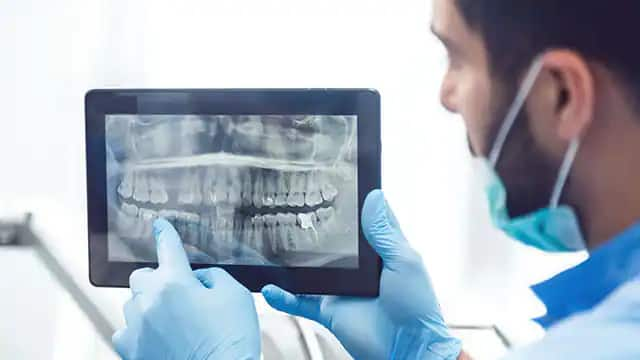Imagine looking at a whole tooth and seeing a line at the very bottom moving upwards. That’s what a vertical root fracture looks like. Vertical root fractures are vertical cracks in your tooth that begin at the root of your tooth and run toward the top of the tooth. Because they normally don’t show signs or symptoms, they can go unnoticed. However, they can lead to an infection in the surrounding bone and gum, which can be noticeable and painful for the patient.
Why Do Vertical Root Fractures Happen?
These fractures are commonly found in weak teeth, teeth that have been treated with a root canal, and other restorative treatments like crown placements. Healthy teeth can also be subject to cracks by chewing on hard materials and foods, like ice. Specifically, when a root canal is being performed, a jolt of pain, sound of popping, or bleeding in the canal might also be a sign of a vertical root fracture that happened during the procedure.
Symptoms of a Vertical Root Fracture
Symptoms of fractures can vary, making this a difficult condition for dental professionals to diagnose. However, signs that you may have a vertical root fracture include:
- Mild pain when biting
- The appearance of a crack when examining with a special light or dye
- A draining sinus tract appearing next to the tooth that looks like a boil or ulcer, which is often a sign that there is an infection beneath the tooth
- A pocket between the gum and the tooth, near the fracture, where the gum essentially detaches from the tooth
A dental professional or specialist (usually an endodontist) may diagnose a fracture during a root canal procedure if they can see a crack. If the fracture occurs after the procedure, they might need to take X-rays, which may show the fractured root characteristically shaped like the letter J, or the specialist may also use a diagnostic method known as transillumination, where they shine a light through your tooth to detect any fracture lines.
How Are Vertical Root Fractures Treated?
There are a few different treatments for a tooth that has a vertical root fracture. In some cases, special types of cement are used to bond the teeth or stop the propagation of the fracture. In most cases, however, the most common treatment is tooth extraction. It's important to have this procedure as soon as a fracture is diagnosed, as chronic infection can eat away at the bone around the tooth, which may be needed in the future to support a dental implant.
To avoid dealing with the fallout of a vertical root fracture, here are some preventive steps you can take to protect your teeth:
- As these fractures occur mostly in teeth treated with a root canal, avoid this treatment if possible. This means scheduling regular dental examinations so your dentist can detect problems early and help you prevent cavities from forming in the first place.
- If you need root canal treatment, ask your endodontist about the root canal filling technique they will use and discuss how to reduce your fracture risk, such as avoiding post-placement.
If your symptoms match those outlined above and you're worried that you may have this type of fracture, talk with your dental professional. They will help you determine the cause of your symptoms and give you the proper treatment to keep your teeth healthy and functioning—so you can worry less and smile more.
Oral Care Center articles are reviewed by an oral health medical professional. This information is for educational purposes only. This content is not intended to be a substitute for professional medical advice, diagnosis or treatment. Always seek the advice of your dentist, physician or other qualified healthcare provider.
ORAL HEALTH QUIZ
What's behind your smile?
Take our Oral Health assessment to get the most from your oral care routine
ORAL HEALTH QUIZ
What's behind your smile?
Take our Oral Health assessment to get the most from your oral care routine















